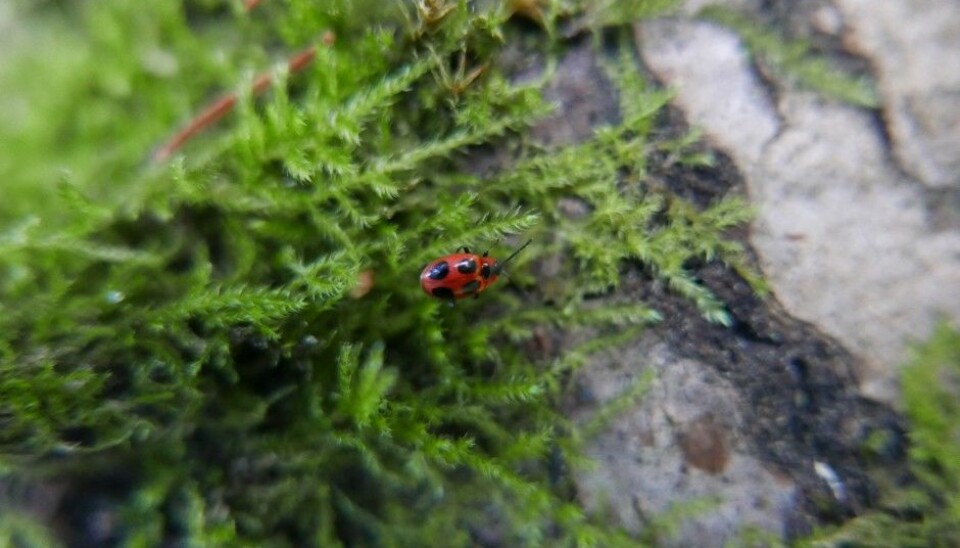An article from Norwegian University of Life Sciences (NMBU)

Clever fungi catch a ride with beetles
Fungi living in wood are very important decomposers. But what do they do when the wood is decomposed and gone? How do they find new food?
With the word 'fungus', most people probably think of typical examples such as amanitas, chanterelles and puffballs. However, this is only a small part of a much larger picture. Most fungi spend the larger part of their lives underground or inside living or dead plants. Hidden in these substrates there is fungi in much larger quantities than the tasty fruits we pick in the fall.
When house and food are one
Thousands of species of insects and fungi live solely within dead wood. It is not easy living both of and inside dead wood at the same time, because the insects and the fungi literally eat their housing and their food.
"As they break down the wood, their habitats disappear, and the next generation must grow up somewhere else," says PhD student Rannveig Jacobsen from the Norwegian University of Life Sciences (NMBU).
This makes dispersal particularly important to them. Wood-living insects disperse mostly by flying and they can use their sight and smell to find a new place of residence. But how do fungi disperse? They certainly lack legs to walk on.
Wind, or something else?
"Well, we assume that wood-living fungi mainly disperse by releasing their spores in the wind," she says.
However, some researchers have long suspected that this is not the whole truth. Jacobsen has spent the last four years investigating whether insects can act as conveyors for the fungi and help them get from one dead tree to another.
"As the insects are actively looking for dead wood, the fungus has a much better chance of finding a good habitat by hitchhiking with them, rather than placing their bets on a random breeze.”
Important decomposers
Fungi are very important to nature because they are one of the few organisms that can break down cellulose and lignin in wood. This makes fungi, along with insects, the most important decomposers of trees. Through decomposition, the plant material is broken down and the nutrients are recycled back to the environment.
"Fungi are particularly important for the decomposition of plant material," she says.
Without fungi and insects, leaves, pine needles, dead trees and plants would have remained intact for much longer.
“They do invaluable work.”
Hitchhiking with insects
By investigating insects that come to fresh dead wood in Norwegian forests, Jacobsen has documented that insects spread fungi to new hunting grounds. These insects include, among others, handsome fungus beetles, sap beetles and round fungus beetles. In one of her experiments, Jacobsen has excluded insects from fresh logs and examined how it affected the establishment of fungi. She found that logs without insects had a different community of fungi than logs with insects.
"The logs without insects also seemed to decompose slower," Jacobsen underlines.
She points out that if the number of individuals and species of insects living in the wood becomes too low, then the decomposition of dead trees and recycling of nutrients in the forest may slow down.
Must factor in the fungi
The amount of dead wood is a key factor for the organisms living in the forest, and an important indicator of the state of the ecosystem. Species living in dead wood constitute about 25 percent of all species associated with forests in the Nordic countries, and the majority of species are insects and fungi. In her doctorate, Jacobsen has shown that insects and fungi have a close relationship and that this connection has important environmental impacts. Fungi form the basis for a food chain comprising a multitude of species within dead wood.
“If some fungi are dependent on certain insect species for dispersal, this must be taken into account for conservation management.”
"If you want to preserve the fungus, you must also preserve the insects," she concludes.
References:
Stokland, J. N., Siitonen, J. & Jonsson, B. G. (2012). Species diversity of saproxylic organisms. In Biodiversity in dead wood, pp. 248-274. Cambridge, United Kingdom: Cambridge University Press.
Jacobsen, R. M., Kauserud, H., Sverdrup-Thygeson, A., Bjorbækmo, M. M. & Birkemoe, T. (2017). Wood-inhabiting insects can function as targeted vectors for decomposer fungi. Fungal Ecology, 29: 76-84. DOI: 10.1016/j.funeco.2017.06.006. CC BY-NC-ND 4.0
Jacobsen, R. M., Birkemoe, T. & Sverdrup‐Thygeson, A. (2015). Priority effects of early successional insects influence late successional fungi in dead wood. Ecology and Evolution, 5 (21): 4896-4905. DOI: 10.1002/ece3.1751. CC BY 4.0
Jacobsen, R. M., Sverdrup-Thygeson, A., Kauserud, H. & Birkemoe, T. Revealing hidden insect-fungus interactions in detritivore networks. Manuscript.
Jacobsen, R. M., Sverdrup-Thygeson, A., Kauserud, H., Mundra, S. & Birkemoe, T. Exclusion of invertebrates influences saprotrophic fungal community and wood decay rate in an experimental field study. Manuscript.
































